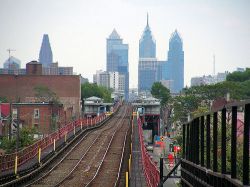
Katherine Gajewski.
Katherine Gajewski was just 29 years old when Philadelphia Mayor Michael Nutter asked her to take on the role of city sustainability director. “I was concerned that people wouldn’t take me seriously,” she says. Three years later, those fears have all but disappeared. Using limited staff and resources, her office works long days to earn Philly a green reputation. “Once people see that you’re really serious and you’re working really hard, age isn’t a factor,” she says.
Gajewski works to implement the ambitious city-wide Greenworks Philadelphia plan [PDF], directs a five-county energy-efficiency program, and even organizes a social group of city employees nicknamed the “Young-ish City Government Workers.” For episode 2 of our Knope and change series, about women who are leading the charge to make our cities more sustainable, Gajewski tells Grist about Philly’s lovely bones and her vision for the future (while also making everyone here feel a bit unaccomplished-ish).
Q. Philadelphia has a rep for being a gritty city.
A. And we’re a really old city. We have great bones — modest-sized, energy-efficient row homes, an extensive public transit system, a really low car ownership rate, a 9,200-acre park system. Those are the type of bones that make for a sustainable city. We’re not a new city that’s building new. We were designed and built smart the first time around. That just happened to be 300 years ago.
We’re a very diverse city. We’re a very poor city. Twenty-five percent of our population is at or below the poverty level. The work we’ve been doing and planning to do raises interesting questions about what people think of as a sustainable city: What kind of environment can provide the highest quality of life and best environmental outcomes? It has cities thinking differently about themselves.
Q. What’s Philly doing that’s unique?
A. Over 1,000 communities in the United States are in non-compliance with the Clean Water Act because of old sewer systems that, in heavy rain events, mix outlets of cities’ wastewater into the waterways. Traditionally, [to come into compliance with the Clean Water Act], that’s meant billion-dollar plans that increase the piping and sewer systems underground so that excess water can be moved through bigger pipes.
Instead of just increasing our grey infrastructure, we’re spending about $2 billion over the next 20-25 years to come into compliance with the Clean Water Act with green infrastructure. We are the first plan of this scale to have approval from the EPA. [The city will use a variety of methods and projects — green roofs, rain gardens, streets with porous pavement, etc. — to slow, absorb, and evaporate stormwater before it overwhelms the sewers.] We are literally transforming half of the city to do this.
Q. Has there been any pushback on your projects?

The City of Brotherly Love. (Photo by connery.cepeda.)
A. We have experienced tremendous support, considering our [Greenworks Philadelphia] plan came out right before the recession hit. I expected more departments to say “We’re focused on our core functions and can’t take anything new on. This does not fit with our priorities.” I haven’t had anyone say, “No. I’m unwilling to do that.” Our mayor has been a leader on this and he’s made it clear that it’s important. But I think it’s also just been an exciting and logical extension of the work a lot of folks are already doing.
Q. Have there been any surprises?
A. In climate adaptation planning, you think about the tie between climate and departments like water, that have an obvious connection. Less so with other departments.
Our health department does our heat health programs in the summer. They help to make sure seniors can get into a safe space so they don’t overheat in their homes. They send out heat alerts. They’ve been working on heat safety and heat warnings for a number of years.
We pulled our climate adaptation planning group together and we said, “We are going to take this work that you are doing and reframe it in the context of climate change.” They easily could have said, “But we’ve been thinking about it like this for so many years and doing work under this framework.” The guy who was running the program said, “Absolutely. This is where it’s going and what we need to be thinking about. I’m in.”
Q. When I think of Philadelphia, I automatically think of the show, It’s Always Sunny in Philadelphia.
A. They hang out in bars in South Philly or something like that? … That’s part of the Philadelphia experience, for sure.
Q. What do you think Philly’s reputation will be in 20 years?
A. In 20 years, half of the city is going to be covered in green infrastructure. That means everything from smart streets to parks and open spaces to green roofs. In 20 years, the city will look and function very differently. At least that’s the goal we are setting out for.
We’re only four years into our [sustainability] plan and already people’s perceptions of Philadelphia are changing. Our population is on the rise. We have more people who are moving into the city.
A lot of people travel between New York and D.C. and miss Philadelphia. When they find it, they are really pleasantly surprised. Our sustainability plan came at the exact right time. It’s helping give vision to the next phase of Philadelphia.
Q. You’ve lived in a lot of different places — from the Bob Marshall Wilderness in Montana to Vermont to Seattle to Chicago. Do you consider yourself an urbanite?
A. The city challenges you in a lot of ways. You meet people who are really different from you every day. Getting to have deep connections or those casual connections help you to think about the world differently. I felt like the city was the place that was going to help me grow the most at this point in my life. But I reserve the right to maybe live in a cabin the woods later on.



